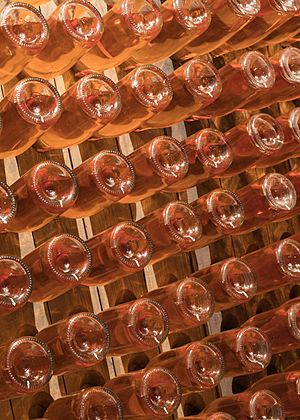Rosé facts for kids
A rosé is a special kind of wine. It gets some of its color from grape skins. But it does not get enough color to be called a red wine. You can think of it as a pink wine! It might be the oldest type of wine ever made. This is because it is quite simple to make using the "skin contact" method. The pink color can be very light, like a pale orange. Or it can be a bright purple-pink. The color depends on the grape varieties used. It also depends on how the wine is made. People usually call it rosé in French, Portuguese, and English-speaking countries. In Spanish, it is called rosado. In Italian, it is called rosato.
There are three main ways to make rosé wine. These are the skin contact method, the saignée method, and blending. Rosé wines can be still, meaning they have no bubbles. They can also be slightly bubbly or very bubbly. They can be very dry or very sweet. For example, Provençal rosé is often dry. White Zinfandels are usually sweet. Rosé wines are made from many different grapes. You can find them all over the world.
How Rosé Wine is Made
When rosé wine is the main product, it is made using the skin contact method. First, black-skinned grapes are crushed. The skins are then left with the juice for a short time. This is usually for two to twenty hours. After this, the grape juice is squeezed. The skins are then thrown away. They are not left in contact during the whole fermentation process. This is different from how red wine is made. The longer the skins stay with the juice, the stronger the color of the final wine will be.
The Saignée Method
Sometimes, a winemaker wants to make red wine stronger. They want it to have more color and a certain taste called tannin. To do this, they can remove some of the pink juice early on. This method is called Saignée. It means "bleeding" in French. When some pink juice is removed, the red wine left in the vats becomes stronger. This is because the amount of juice is less. So, the juice left with the skins becomes more concentrated. The pink juice that was removed can then be fermented separately. This makes rosé wine.
Blending Wines
Mixing red wine into white wine to make it pink is not common. Most wine-growing areas do not allow it. In France, it is against the law. But there is one exception: Champagne. Even in Champagne, some top producers do not use this method. They prefer the saignée method instead.
See also
 In Spanish: Vino rosado para niños
In Spanish: Vino rosado para niños
- Clairet, a very dark rosé. Some people think it is its own type of wine.
- Rosé apple cider, made from red-fleshed applecrabs.
- Frosé, a mixed drink made with frozen rosé. It often includes strawberries, vodka, and lemon juice.


